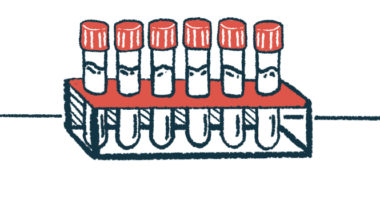SMA Jokela Type Shows Distinct Biomarker Profile of Muscle Damage

Blood biomarker levels of muscle damage — rather than nerve cell damage — are significantly altered in people with a rare form of adult-onset spinal muscular atrophy (SMA) called the Jokela type (SMAJ), according to a study in Finland.
Also, the levels of creatinine, a biomarker of muscle mass, are associated with disease severity, suggesting its use as a way to monitor disease progression and treatment response in SMAJ.
This biomarker profile more closely resembles that of spinal and bulbar muscular atrophy (SBMA), another rare form of adult-onset SMA, than that of classic SMA — in which neurofilament light chain (NfL), a biomarker for neuronal damage, is typically increased.
The absence of higher-than-normal NfL levels in these two rare forms may be related to their slowly progressive nature, and suggests that this biomarker may be used to distinguish between rapidly progressive motor neuron diseases and those that progress slower, the researchers wrote.
The study, “Serum Creatine, Not Neurofilament Light, Is Elevated in CHCHD10-Linked Spinal Muscular Atrophy,” was published in the journal Frontiers in Neurology.
Spinal muscular atrophies are a group of disorders characterized by the gradual loss of motor neurons, the specialized nerve cells that control voluntary movement, resulting in progressive muscle weakness and wasting.
The classic form of SMA — from its prenatal– to adult-onset types — is caused by mutations in both copies of the SMN1 gene. However, a number of rarer types of SMA, with varying clinical profiles, are associated with mutations in genes other than SMN1.
SMAJ, also known as late-onset spinal motor neuronopathy, is a slowly progressive form caused by a mutation, c.197G>Tp.G66V, in a single copy of the CHCHD10 gene. This gene provides instruction to produce a protein found in mitochondria, which provide energy to cells, but whose function remains unclear.
With a symptom onset usually around 30–40 years of age, SMAJ is characterized by muscle cramps and twitches, reduced muscle reflexes, muscle weakness predominantly in the lower limbs, and progressive walking difficulties. It is more commonly found among the Finnish population.
People with SMAJ may be initially misdiagnosed with amyotrophic lateral sclerosis (ALS), another type of motor neuron disease, or Charcot-Marie-Tooth disease, a neurologic condition characterized by both motor and sensory defects.
Identifying SMAJ biomarkers may help to diagnose, predict, and monitor disease progression, as well as to better understand its underlying mechanisms, and/or evaluate treatment responses in clinical trials.
With this in mind, a team of researchers in Finland analyzed blood biomarkers of neuronal damage (NfL and glial fibrillary acidic protein, or GFAP) and muscle damage (creatine kinase) in 49 SMAJ patients (29 women and 20 men) and 45 age- and sex-matched healthy people who served as controls.
NfL are major structural proteins of neurons and their presence in the blood is a sign of neuronal degeneration, while GFAP is a marker of an abnormal increase in neuron-supporting cells due to neuronal loss. Creatine kinase (CK) is an enzyme that leaks out of muscles as they deteriorate.
The median age of the patients was 65 years (range of 39–86 years).
Results showed that the levels of NfL were similar between SMAJ patients and healthy people, while GFAP levels were significantly lower among patients.
“The fact that SMAJ is slowly progressive and largely restricted to lower limbs may mean that the number of actively degenerating spinal motor neurons is not sufficient to elevate NfL,” the researchers wrote.
The lower GFAP levels in SMAJ patients may suggest that activation of a type of neuron-supporting cells, called astrocytes, may be impaired, “but more studies are needed before any strong conclusions regarding this can be drawn,” the team added.
In turn, blood CK levels were higher than the normal range in 60% of female patients and 95% of male patients, highlighting the main role of muscle damage in SMAJ.
Further blood analyses showed that, relative to controls, SMAJ was associated with significantly higher levels of creatine and pyruvate, and lower levels of creatinine, taurine, N-acetyl-carnosine, and succinate.
Creatine is converted into creatinine, a waste product of the normal breakdown of muscle tissue, with high creatinine levels indicating more muscle mass. As such, excess creatine and low creatinine suggest reduced muscle mass.
“In addition to creatinine, decreased levels of taurine and N-acetyl-L-carnosine may also be indicators of a decreased muscle mass in SMAJ,” the researchers wrote, adding that “altered pyruvate and succinate indicated a metabolic response to mitochondrial dysfunction.”
Higher levels of creatine were significantly associated with more severe disease in people with SMAJ; no associations were detected for the other molecules.
The biomarker profile for SMAJ patients was similar to that reported for people with SBMA, another rare adult-onset form of SMA in which muscle injury appears to play a major role. SBMA patients show normal NfL levels, increased levels of CK and creatine, and reduced creatinine levels.
As such, “the degree of muscle injury in SMAJ and SBMA appears enough to elevate the CK,” the team wrote.
These findings highlight that “biomarkers of muscle mass and damage are altered in SMAJ [blood], indicating a role for skeletal muscle in disease [mechanisms] in addition to [motor neuron] damage,” the researchers wrote.
Also, NfL levels may be used to “differentiate SMAJ from early-stage ALS, and, perhaps, more generally, between rapidly and slowly progressive motor neuron diseases,” they added.
The results also suggest several potential biomarkers of SMAJ, whose clinical utility has to be confirmed in larger, prospective studies.
In addition, SMAJ was associated with mild changes in mitochondrial metabolism, suggesting that “therapies designed for primary mitochondrial diseases may also be worth testing in SMAJ,” the team wrote.









